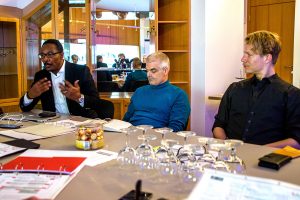In November 2018, Jon Bergmann1 visited Istanbul and presented there the „187 Global Elements for Effective Flipped Learning“. On this summit, Flipped Learning 3.0 was completed and available for public to be used in teaching and training.
Two days later, Jon and Errol St. Claire Smith (from the FLGlobal) attended the kickoff meeting of this project in Wiener Neustadt, Austria. Here the first discussion of these elements for use in Adult Education took place.
Here is an overview of the Elements (93 of them are the core elements and will be used in the frame of this project). The elements are collected in groups like the periodic system; 12 different groups exist.
1. Communication and Culture (7 elements)
Communication covers the bidirectional communication (between Teachers/trainers and students as well as student to student). Culture addresses “how” the teaching/training and learning is done. A basic approach to culture is the mutual respect and interaction with each other and the knowledge that making mistakes is not a sign of failure.
2. Professional Development (5 elements)
The professional development addresses mainly the teacher/trainer. Avoiding any standstill is fundamental here. This means responding to innovations, constant further training and education and, as a significant part, networking at local and global levels.
3. Individual Space Mastery (18 elements)
This group addresses the learner as a single person and the impact of the teacher/trainer to the learner. An essential focus is set on the pre-class learning and the benefits or added value for the learner as well as the skills the trainer must have to implement this pre-class training for learners.
4. Group Space Mastery (15 elements)
The cooperation and collaboration of learners is the core element in this group. Most elements assembled in this group have a special focus on active learning.
5. K12 focused (4 elements)
K12 identifies the duty and the contribution of the parents to the learning success of their children as a crucial continuous thread. Therefore, it is more or less not valid for Adult Education, even though the life partners of the learners partly take on the role of parents.
6. Evidence and Research (4 elements)
To be well informed is a basic duty of any educator. This means to read research as well as to do the own research (as action research in the class or during the Distance Learning phase) and to stay connected with researchers.
7. Learning spaces (5 elements)
This group cares about the used learning spaces, their practical and efficient implementation in the learning and the added value for the students.
8. IT Infrastructure (5 elements)
IT plays an extremely important role in Flipped Learning 3.0: Content and activities are using Multimedia, active learning is also deeply connected with the use of technology, and especially the individual space makes intensive use of ICT. From this it can be deduced that digitization occupies an important place in flipped learning and therefore different areas, such as the tools used or the protection of privacy – to name just two topics – are important.
9. Student Feedback (5 elements)
Feedback and feedback culture have an essential influence on the learning success. The five elements in this group determine how feedback should be done to foster efficient learning.
10. Assessment (7 elements)
Assessment is traditionally used to evaluate the learning success – this is the same in Flipped Learning 3.0. The elements in this group describe and give suggestions, how effective and useful assessments should be implemented and executed.
11. Understanding Flipped Learning (6 elements)
Basic considerations and recommendations are the content of the elements in this group. These elements enable to understand the basic approach to Flipped Learning and are essentials to use Flipped Learning 3.0.
12. Planning Flipped Learning (12 elements)
These 12 elements provide a summary of essentials to implement a Flipped Learning approach to teaching. They cover practical basics that result from the Understanding Flipped Learning Group.
Here is the element table:

Element table of the 93 core elements (187 Global Elements of Effective Flipped Learning)2.
© by the Flipped Learning Global and AALAS (Academy of Active Learning Arts and Science)
____________________
1 Jon Bergmann is one of the pioneers of the Flipped Class Movement and the developer of Flipped Learning 3.0. Jon is leading the worldwide adoption of flipped learning by working with governments, schools, corporations and education non-profits. Jon is coordinating or guiding flipped learning initiatives around the globe including China, Taiwan, Korea, Australia, Singapore, Thailand, the Middle East, Iceland, Sweden, Norway, the United Kingdom, Italy, Spain, Mexico, Canada, South America, and the United States.
Jon is the author of seven books including the bestselling book: Flip Your Classroom which has been translated into 10 languages.He is the founder of the global FlipCon conferences which are dynamic engaging events which inspire educators to transform their practice through flipped learning.
2 Published with the autorisation of the FLGlogal, in the frame of the cooperation contract with the FLGlobal.
Hint: You are not allowed to use this table in your publication, to copy it or download it. This material is copyright protected.
About the Author: Peter Mazohl is science teacher in Austria, the head of the European Initiative for Education and the project manager of this project.


I have a school can you help the school children in any kind